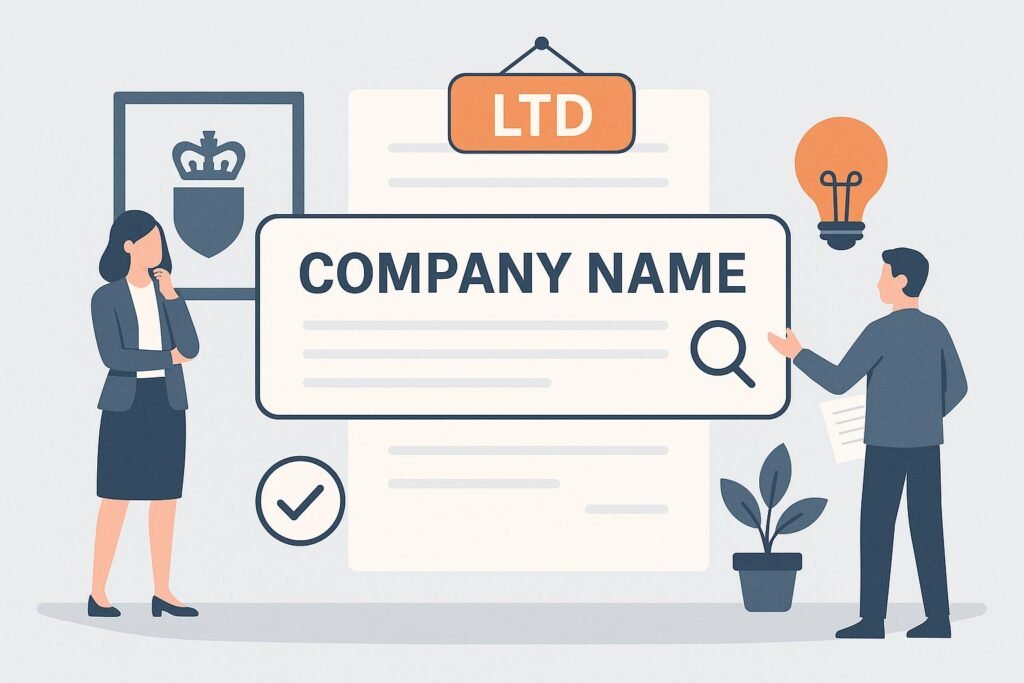
Before you set up a limited company, you need to choose a suitable company name.
Here we look at some important naming rules you need to know.
If you fall foul of the official company naming guidelines, Companies House will simply reject your company formation application.
Or, you could face a challenge in the future if you accidentally breach a trademark, or your name is too similar to an existing entry on the official register.
If you’re setting up as self-employed, read this separate guide to choosing a sole trader name.
Choosing a limited company name – the rules
Here is an overview of the rules you should know when choosing a limited company name.
Your company name must be unique
Before you get started, you can search the Companies House register to see if your preferred name is available.
Your suggested name cannot be the same as an existing entry in the register.
Being the ‘same as’ includes a name which is different only by virtue of adding a symbol or punctuation mark.
Your name cannot be too like an existing entry either.
For example, “Best Electrix Luton Limited” is too like “Best Electrics Luton Limited”.
You may be asked to change your name at a future date should an existing company make a complaint to Companies House if your name is too similar to theirs.
You must include the words ‘limited’ or ‘ltd’ in most cases
Each private limited company name must include a ‘Limited’ or ‘Ltd’ suffix (such as Joe Bloggs Limited). There are a few exemptions from this rule; for charities or if your company is limited by guarantee.
If your company’s registered office address is in Wales you can choose to use the Welsh suffix “cyfyngedig” or “cyf”.
Words and terms you cannot use
There are some words and terms you cannot use – unless you have permission to do so.
Sensitive words and expressions
You cannot use so-called ‘sensitive’ words unless you have received official permission.
At the time of writing (Jan 2024), there currently are 134 words and expressions on the list.
Here are some examples of sensitive words you cannot use:
- Bank or Fund (unless you have authority from the FCA)
- Dental (unless you have permission from the General Dental Council)
- Foundation (unless you are a company limited by guarantee)
- Windsor!
You can read the full list here. (Annex A)
Words which imply a connection to a public sector body
You cannot use words which imply some kind of link with a government department, a devolved institution, or council.
You can read the full list here. (Annex B).
You should not choose an ‘offensive’, ‘abusive’, or ‘illegal’ company name.
Not only would that be an odd thing to do for obvious business reasons, but your choice could also be rejected.
Trade Marks
Don’t choose a name with trademarked words, or words deliberately used to resemble them. You may have trouble later on if you do so.
To avoid trademarked names when incorporating a limited company, you should check the UK’s Intellectual Property Office’s Trade Mark Register.
Once you form a limited company, your name will be protected by Companies House. No other applicants can choose a name that is too similar to yours.
Can I use a different business name when running a company?
Your company is a legal entity, but you can carry on business using a different name if you choose.
This is known as your ‘trading name’.
Again, with trading names, you mustn’t use any offensive words, or ‘sensitive’ words (unless you have permission.
With trading names, you cannot use the suffixes ‘limited’ or ‘ltd’. These can only be used with your official limited company name.
Consider choosing a matching domain name
It’s not a requirement, but it’s a good idea to try to secure a matching domain name for your new company name.
This will provide you with seamless branding, and an email address to match your company name.
Alongside the .co.uk domain name suffix, we also recommend you try to secure the .com domain as well, to protect your online identity.
With fierce competition for short, snappy domain names, there has been a trend in recent years for business owners to find a suitable domain name first, and then name their company after their preferred web address.
If your business will have a significant online presence, this makes complete sense.
What if I want to change my company’s name in the future?
Assuming you haven’t been asked to do so by Companies House, due to breaching one of the rules listed above, it is very simple to change a company name.
To submit a change of name to companies house, you have to either:
- Pass a special resolution
- Refer to permission pre-existing in your company’s Articles of Association
You can submit the change via the Companies House online service, and pay an £8 fee. It can take a few days for Companies House to confirm the change. If you need the change processed urgently, there is also a £30 same day service.
Alternatively, you can use the paper form NM01. This costs £10.
For cases where the change is granted by the Articles of Association, you need to use paper form NM04.
Where you should display your company name
According to government rules, you should display your company name at your registered address. However, if you run your business from your home address, or own a dormant company, you don’t need to comply with this rule.
You should display your company’s name, address and registered number on any official company paperwork and your website (if you have one).
If a location has more than five companies registered at the same address, it may use alternative display options (e.g. accountants and company formation services).
And finally, if you decide to display any director’s names at your registered address or on paperwork, you have to display all of them – or none at all

